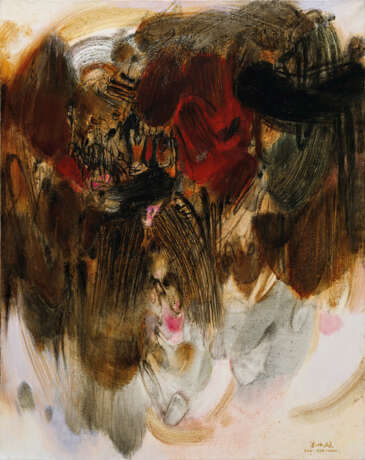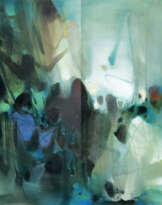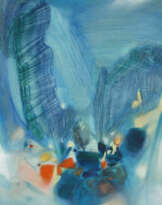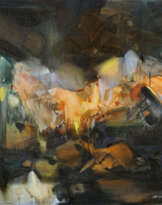ID 871761
Lot 216 | CHU TEH-CHUN (ZHU DEQUN, 1920-2014)
Valeur estimée
HKD 5 000 000 – 8 000 000
No. 182 Plénitude de la Maturité
signed in Chinese, signed ‘CHU TEH-CHUN’ (lower right); signed and titled in Chinese, signed, dated and titled ‘CHU TEH-CHUN 1964 No. 182 “Plenitude de la maturité”’ (on the reverse)
oil on canvas
91.5 x 72.8 cm. (36 x 28 5/8 in.)
Painted in 1964
Provenance
Private Collection, France
Christie’s Hong Kong, 26 May 2018, lot 1
Acquired at the above sale by the present owner
The authenticity of the artwork has been confirmed by Fondation Chu Teh-Chun (https:// chu-teh-chun.org), Geneva. This work is referenced in the archive of the Fondation Chu Teh-Chun and will be included in the artist’s catalogue raisonne prepared by Fondation Chu Teh-Chun. A certificate of authenticity can be requested for the successful buyer.
Special notice
On occasion, Christie's has a direct financial interest in the outcome of the sale of certain lots consigned for sale. This will usually be where it has guaranteed to the Seller that whatever the outcome of the auction, the Seller will receive a minimum sale price for the work. This is known as a minimum price guarantee. This is such a lot.
Where Christie’s has provided a Minimum Price Guarantee, it is at risk of making a loss, which can be significant if the lot fails to sell. Christie’s therefore sometimes chooses to share that risk with a third party who agrees prior to the auction to place an irrevocable written bid on the lot. If there are no other higher bids, the third party commits to buy the lot at the level of their irrevocable written bid. In doing so, the third party takes on all or part of the risk of the lot not being sold. Christie''s compensates the third party in exchange for accepting this risk provided that the third party is not the successful bidder.
The remuneration to the third party may either be based on a fixed fee or an amount calculated against the final hammer price. The third party may also bid for the lot above the irrevocable written bid. Where the third party is the successful bidder, the third party is required to pay the hammer price and the buyer’s premium in full. Third party guarantors are required by us to disclose to anyone they are advising their financial interest in any lots they are guaranteeing. However, for the avoidance of any doubt, if you are advised by or bidding through an agent on a lot identified as being subject to a third party guarantee you should always ask your agent to confirm whether or not he or she has a financial interest in relation to the lot.
Post lot text
Ripe, ruddy fruit hangs among luxuriant leaves and branches, signifying a rich harvest after a full season. Chu Teh-Chun's Composition No. 182 – Plénitude de la Maturité (Lot 1), dating from 1964, is signed by the artist on the reverse, along with the inscription 'Plénitude de la Maturité' in both French and Chinese. By 1964, after living in France nearly 10 years, undergoing many difficulties and experimental phases, Chu had reached a point of growing maturity and control over his abstract art. 'Plénitude' signifies the harvest one had hoped for, and metaphorically speaks of the fruits of success in the artist's journey as he nears a new summit in his career in abstract art.
The year after his arrival in France, Chu Teh- Chun was deeply impacted by a retrospective of work by the artist Nicolas de Staël; the event was crucial to his decision to move from figurative to more abstract styles. Chu described it this way:'His (de Staël's) influence on me had nothing to do with what he painted. What inspired me was his attitude of freedom toward painting.'The inspiration Chu derived from de Staël clearly was not limited to artistic style, but had to do with his conviction about freedom in painting. He suddenly realized that the 'invisible hand' that was restricting him was nothing other than 'forms', and only by abandoning 'forms' could his paintings become truly revealing and expressive. This kind of bold, free abstract expression is fully embodied in Chu's Composition No. 182 – Plénitude de la Maturité . No longer is he restricted by the outer form of his subject: Pure, free, expressive lines in black dominate the canvas, varying in depth and density like spreading washes of ink and portraying a rich visual world with harmonious rhythms.
In painting, figuration and abstraction are often seen as opposing ends of a spectrum. Chu Teh-Chun, however, believed that in abstraction, figuration was simply internalized, not negated. He said that he often thought of a sentence from Laozi, describing the Dao: 'What is called the Way is elusive and intangible. Intangible and elusive, yet within it are thought-images. Elusive and intangible, yet within it are objects.' The methods of expression in abstract art may be elusive and intangible, yet viewers may still find that tangible, figurative things are represented within them.
Chu Teh-Chun especially noted his works in the 60s often reflected deep mental impressions that stayed with him afterspending time in nature. The landscapes he saw would be internalized as abstract expressions of feelings about what he saw,and these converted mental images would then pour out artistically onto the canvas. In Composition No. 182 – Plénitude de la Maturité we likewise find that vague impressions of a majestic, towering mountain ridge have found their way onto the canvas, after being turned over in the artist's mind, while the center is occupied with the living energy of ripe, red fruit, exuding a youthful vibrancy amid impressions of mountain and forest. Chu also held the Song Dynasty landscape painters in highest esteem, and seeing Composition No. 182 – Plénitude de la Maturité , one has to be reminded of Guo Xi's Early Spring : Bothemploy a broad composition that takes in their full subject, with sky above and earth below. Chu further smartly uses the thickness of his lines, as well as varying brushstroke speeds and depths of colour, to suggest foreground, middle ground and background on his canvas.
Born in an Eastern culture context, the lines Chu employs reach beyond the ordinary painterly functions required by a composition, by further extending the calligraphic nature of line and the philosophy of the Chinese writing system. In Composition No. 182 – Plénitude de la Maturité , the lines have exhilarating energy and freshness, alternating between fast and slow, heavy and light, as Chu freely explores the relationship between lines and forms in space. Another artist famous for expressive lines was the Western abstract painter Hans Hartung, who believed that lines were geometric forms produced by unconscious action. He therefore stressed the artist's physical movements during the creative process and their existential quality, using lines to establish spaces inhabited by surreal images. By contrast with Hartung's pure, unconscious movements, Chu ingeniously reinterprets the meaning of the old Chinese adage that 'painting and calligraphy spring from the same source.' He makes line a part of his modern painter's vocabulary, and as these calligraphic lines play off against other elements in his painting, they inject an extra element of Eastern philosophy and Zen-like thought into his work. 'The idea precedes the first movement of the brush': The idea informs the painting, and the lines build that idea into a wonderfully realized and artistic conception of space.
In his abstract work, Chu Teh-Chun embraced the rationality of 'cold abstraction' and the emotionality of 'hot abstraction,' as well as a more impressionistic Chinese style of abstraction. Drawing deeply on the energies of life and his artistic experience, he transformed them into an utterly pure and personal artistic language. To view a Chu Teh-Chun abstract landscape is to commune with the universe, to seek its origins and connect with the essence of life. But such an experience provides aswell a path to understanding the inner feelings of the artist and the grand breadth of his character.
| Artiste: | Chu Teh-Chun (1920 - 2014) |
|---|---|
| Technique appliquée: | Huile sur toile |
| Style artistique: | Art abstrait |
| Lieu d'origine: | France, Europe |
| Catégorie maison de vente aux enchères: | Peintures |
| Artiste: | Chu Teh-Chun (1920 - 2014) |
|---|---|
| Technique appliquée: | Huile sur toile |
| Style artistique: | Art abstrait |
| Lieu d'origine: | France, Europe |
| Catégorie maison de vente aux enchères: | Peintures |
| Adresse de l'enchère |
CHRISTIE'S 18 Chater Road Central Hong Kong Hong Kong | ||||||||||||||
|---|---|---|---|---|---|---|---|---|---|---|---|---|---|---|---|
| Aperçu |
| ||||||||||||||
| Téléphone | +85227601766 | ||||||||||||||
| Fax | +852 2760 1767 | ||||||||||||||
| Conditions d'utilisation | Conditions d'utilisation | ||||||||||||||
| Heures d'ouverture | Heures d'ouverture
|












